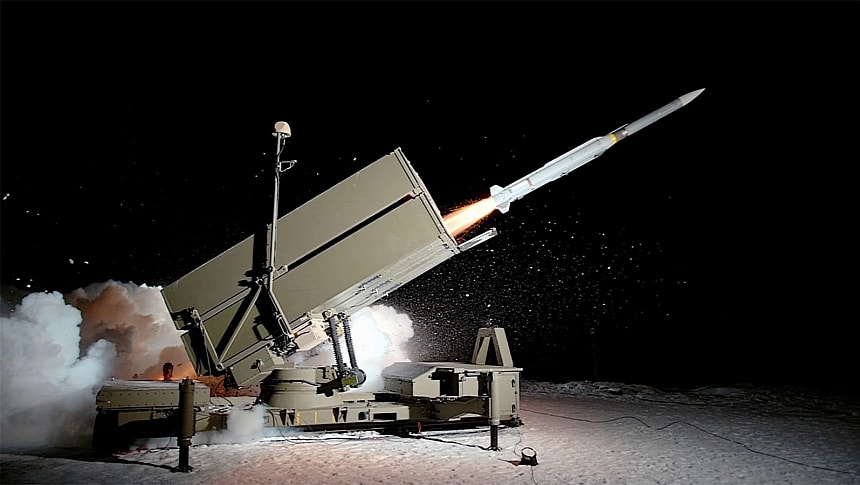The war in Ukraine has brought into the spotlight a series of weapons platforms and weapons that until the conflict started had never been used on such a large scale. One of them is the so-called NASAMS.
NASAMS is an acronym for National Advanced Surface-to-Air Missile System or, because it is made by Raytheon together with Norwegian company Kongsberg Defence & Aerospace, the Norwegian Advanced Surface-to-Air Missile System. Just like its expanded name says, it has been specifically designed to bring down enemy aircraft or other airborne threats.
The system has been around since 1997, and it generally uses for weapons a type of missile known as the Advanced Medium-Range Air-to-Air Missile (AMRAAM). It too made by Raytheon, it is described as "the world's most sophisticated, combat-proven air dominance weapon."
A standard missile of this variety, the AIM-120, has become a weapon of choice for fighter jets, including the F-15, F-16, F/A-18, F-22, Eurofighter Typhoon, JAS-39 Gripen, Tornado and Harrier. The same kind is also used as ammunition for the NASAMS, and it can generally strike targets located as far away as 100 miles (160 km) from where it is fired.
But as the battlefields in Ukraine have shown, that range might just not be enough, so an even more potent variant of the missile is currently in the works. Called AMRAAM-Extended Range (ER), it is meant to intercept targets at longer distances and higher altitudes.
Although what that actually means is not public knowledge, we do know a thing or two about what makes this missile tick.
The thing uses a bigger rocket motor, a 10-inch piece of hardware supplied by defense contractor Nammo. A 10-inch control actuator system made by Kongsberg is also used, creating a system its makers like to call the Norwegian Propulsion Stack. Separately, the weapon is also equipped with optimized flight control algorithms.
The thing was recently put to the test for the first time in connection with a NASAMS system over in Norway, with the help of the local military. The AMRAAM-ER, in a first-of-its-kind configuration that used the guidance section of the AIM-120 C-8, was loaded and fired from the air defense system, then went on to fly a pre-programmed path for its operators to properly assess both the launcher's and the missile's performance. Naturally, we're not being given the specifics of the test, but we are told it was a success.
By the looks of it, the AMRAAM weapon will evolve even more in the months ahead, as its makers also have something in the pipeline they describe as "agile software upgrades." Separately, an aircraft-carried version called AIM-120D-3 is currently getting ready to enter production.
The cost of a single AMRAAM missile is estimated at $1 million, and during its 30+ years of existence (Ukraine war not included), it only brought down around 20 enemy aircraft in conflicts around the world.
The system has been around since 1997, and it generally uses for weapons a type of missile known as the Advanced Medium-Range Air-to-Air Missile (AMRAAM). It too made by Raytheon, it is described as "the world's most sophisticated, combat-proven air dominance weapon."
A standard missile of this variety, the AIM-120, has become a weapon of choice for fighter jets, including the F-15, F-16, F/A-18, F-22, Eurofighter Typhoon, JAS-39 Gripen, Tornado and Harrier. The same kind is also used as ammunition for the NASAMS, and it can generally strike targets located as far away as 100 miles (160 km) from where it is fired.
But as the battlefields in Ukraine have shown, that range might just not be enough, so an even more potent variant of the missile is currently in the works. Called AMRAAM-Extended Range (ER), it is meant to intercept targets at longer distances and higher altitudes.
Although what that actually means is not public knowledge, we do know a thing or two about what makes this missile tick.
The thing uses a bigger rocket motor, a 10-inch piece of hardware supplied by defense contractor Nammo. A 10-inch control actuator system made by Kongsberg is also used, creating a system its makers like to call the Norwegian Propulsion Stack. Separately, the weapon is also equipped with optimized flight control algorithms.
The thing was recently put to the test for the first time in connection with a NASAMS system over in Norway, with the help of the local military. The AMRAAM-ER, in a first-of-its-kind configuration that used the guidance section of the AIM-120 C-8, was loaded and fired from the air defense system, then went on to fly a pre-programmed path for its operators to properly assess both the launcher's and the missile's performance. Naturally, we're not being given the specifics of the test, but we are told it was a success.
By the looks of it, the AMRAAM weapon will evolve even more in the months ahead, as its makers also have something in the pipeline they describe as "agile software upgrades." Separately, an aircraft-carried version called AIM-120D-3 is currently getting ready to enter production.
The cost of a single AMRAAM missile is estimated at $1 million, and during its 30+ years of existence (Ukraine war not included), it only brought down around 20 enemy aircraft in conflicts around the world.




















